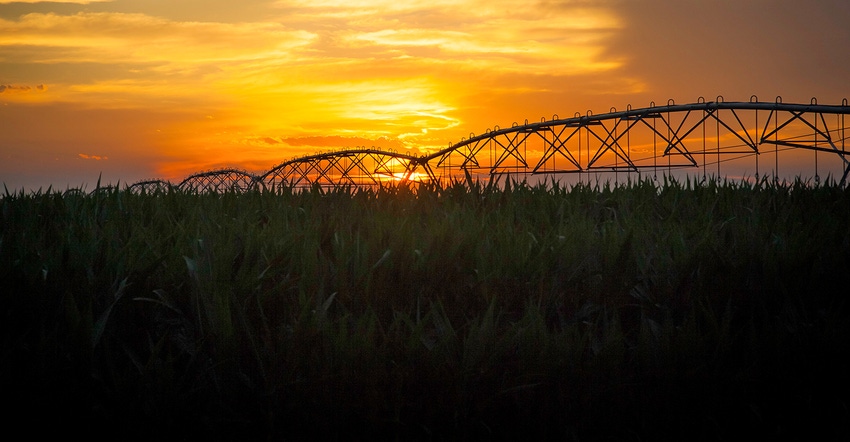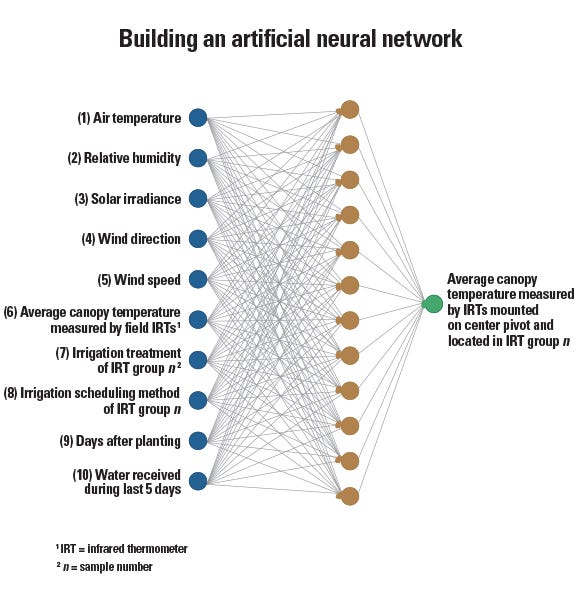January 10, 2019

Farmers are going to be hearing a lot more about artificial intelligence and machine learning in the coming years. From identifying weeds from a single smartphone picture to managing engine fuel use more precisely, these systems are being put to work in a number of ways.
During the Irrigation Show in Long Beach, Calif., in late 2018, Manual Alejandro Andrade, a researcher at the Oak Ridge Institute for Science and Education in Oak Ridge, Tenn., shared results of his work with machine learning. What he found is that a properly trained artificial neural network can be as effective in building an irrigation schedule as pulling live data from sensors to build the prescription.
While his work is preliminary — and he reported that more work would be needed in more variable situations — the study shows the promise of how these networks can take a range of data and make decisions more efficiently.

This diagram shows how an artificial neural network is constructed. Many inputs are provided to the network tool (represented in light brown) to achieve a specific outcome — in this case, predicting average canopy temperature. With the network, more input improves the outcome over time.
How machine learning works
“The elements of an artificial neural network include three layers. The first is all the information relevant to the problem,” Andrade said. “The second is the output you expect to receive. And the third is the output’s variable response.”
It is a very technical topic, so he broke it down using cat identification as an example. Providing a large number of photos of different kinds of cats, along with some relevant information — pointy ears, whiskers, furry, gleaming eyes, furry tail and other details — into the neural network, you train the system to look for specific features.
Then, when an image of a cat — not even a photograph — is provided, the network can properly determine if the picture is a cat or not. The massive upfront information helps train the network to make future decisions.
In irrigation, canopy temperature can be an indicator of water stress, and using infrared sensors to measure it is a noninvasive way to capture information, Andrade said. Capturing infrared information across a center pivot is one way to gather needed information for developing a prescription map for water use.
Sensors and neural networks
In his work in Bushland, Texas, Andrade mounted infrared sensors on a three-span center pivot to collect canopy temperature information. To train the network, Andrade and his colleagues ran the pivot dry over the field three times to train the system. Canopy temperatures estimated using the neural network were compared against canopy temperatures measured by the network of infrared sensors during the fourth scan.
In another case, data from the first six scans were used to train the network. Then, neural network-predicted canopy temperatures were compared against measured temperatures during a seventh scan.
Andrade noted that the aim of training the network to predict canopy stress was designed to provide more information to a scheduling program. What they found is that the neural network can get pretty close to providing a useful prescription through its prediction, rather than actual measurement. This can be valuable when building a prescription, because weather can affect capturing crop canopy sensor data.
In the first study, the neural network predictive prescription map matched the prescription built using sensor data within an acceptable margin for error. However, Andrade noted that in that first case study, the Texas location got rainfall, and soil moisture changes reduced canopy temperatures. That differed from the second study, where changes in canopy temperature were more significant.
“It was harder for [the neural network] to accurately estimate temperature in the second case, because changes in the field were more significant,” he said.
Essentially, high variability did lead to different results in the second study, though the neural network only provided one prescription map that differed from the sensor-based map. “Eventually, we will be able to generate a prescription map based on canopy temps. We’re looking to research this in more variable fields in the future,” he said.
The key is that neural networks can be trained to do predictive maps based on in-field data from remote sensors and other information that can increase accuracy of water use.
About the Author(s)
You May Also Like






